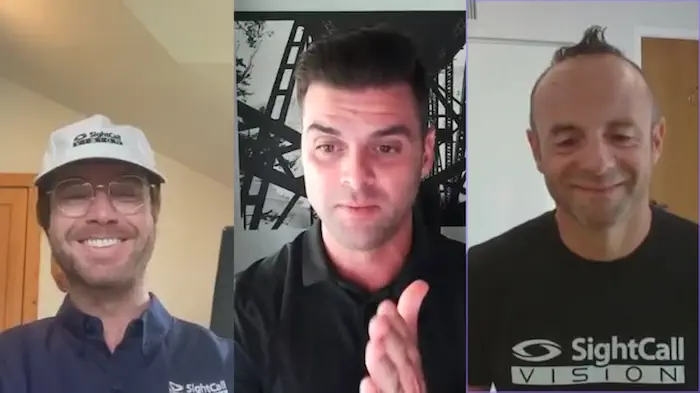In This Episode...
In this episode of SightCall Sessions, we sit down with Justin O’Brien, VP of Sales for existing customers at NICE, one of the leading CCaaS platforms in the market. Justin shares his journey in the customer experience industry, offering insights into what sets NICE apart as an innovator in the competitive CCaaS space.
From leveraging partnerships like SightCall to pushing the envelope with cutting-edge AI technologies, Justin delves into how NICE is helping businesses meet the evolving expectations of today’s consumers. He emphasizes the importance of creating frictionless customer experiences and the role of strong partnerships in delivering seamless, integrated solutions that enhance customer journeys.
Episode Transcript
David Swift (00:00):
Welcome everyone to SightCall Sessions.
SightCall Sessions is a conversation focused on enterprise service, topics, trends, and technology. Today, we’re fortunate to have Justin O’Brien, VP of Sales for existing customers at none other than NICE—one of the largest and greatest (in my opinion) CCaaS platforms out there.
We also have Fred with us, our EVP at SightCall for sales and partnerships. We’re really excited to have you, Justin.
Justin O’Brien (00:35):
Thank you so much for having me. I appreciate the introduction—you make me feel very important.
As you know, David, I often introduce myself as a high-functioning idiot. I say that to caution viewers that I’m just a nobody trying to tell anybody about the awesome stuff going on in CCaaS and, more specifically, in the world of customer experience transformation—which, of course, you guys are a major part of.
David Swift (01:09):
Let’s get started with some questions. First up—could you tell us about your role at NICE and your journey in the customer experience industry?
Justin O’Brien (01:20):
Sure. My current role is focused on working with our existing customer base. NICE has been around since 1986, and over the years, we’ve accumulated more than 7,000 customers globally. In North America, we serve around 5,500 across a wide range of industries.
My team—solution account management—works on consolidation, transformation, and expansion initiatives with those customers. It’s an exciting time because there’s so much innovation in the space, and NICE has been a key player in driving it.
We’re not just releasing products—we’re delivering solutions that integrate across the customer journey, from the initial need (booking appointments, filing warranty claims, etc.) to resolution. Whether it starts via phone, chat, Facebook, or a Google search, NICE enables full journey orchestration.
As for how I got here? I started off as a salesperson. Actually, I was an actor by trade and needed a “real job.” I landed at a call recording and quality monitoring company. Funny story—I once accidentally told a client named Crystal that I loved her on the phone because my wife’s name is also Crystal. It was a mess! But a week later, I closed the largest deal the company had ever seen.
That moment taught me: sales is easy when you’re just yourself. I’ve now been at NICE for over 13 years.
David Swift (04:14):
That’s quite the journey. NICE comes up a lot in our space as a leader in CCaaS. From your perspective, what sets NICE apart?
Justin O’Brien (04:33):
You’re putting me on the spot! All my competitors are probably watching, looking for the secret sauce.
The corporate answer? NICE has never shied away from innovation. We push the envelope with internal development. Many technologies our competitors now use started with us. We’ve built brand equity over the years—when customers have to choose, they often go with the name they trust.
But we also know where to partner. Instead of saying, “we don’t offer that,” we find best-in-breed partners—like SightCall—and integrate them seamlessly. That way, we deliver a unified experience to our customers.
Personally? It comes down to people. Customer care is the only sustainable competitive advantage. And people buy from people they trust.
Fred (06:34):
To that point—Justin, you’re not just smart and charming, you’re incredibly efficient. That mindset runs throughout NICE, which is why you’re so successful.
Justin O’Brien (07:34):
Stop… keep it coming. No really, thank you. You’re right—it has to come from a passion for customer care.
One of my first jobs was at Subway. I was told, “a sandwich tastes better if the customer has a smile on their face.” That’s stuck with me. If you’re constantly improving the customer experience, the results will compound.
I’m lucky to work for a company where that’s our central focus.
Fred (08:54):
Let’s talk partnerships. Why is it so important for NICE to work with DEVone partners like SightCall?
Justin O’Brien (09:29):
Even with all our innovation and tech, customer needs evolve fast. We can’t always meet those needs with our own tools—and that’s okay. Sometimes the best outcome comes from a partnership.
That’s where DEVone comes in. We don’t partner with just anyone. SightCall is one of a very small number of strategic partners. Your visual assistance solution blew our minds.
When I saw your demo, I wasn’t just thinking as a seller—I thought, “Man, I wish I had this on some of my recent service calls!” The ability to share what I’m seeing and expedite the process—it’s a game-changer.
David Swift (12:26):
I’ve been there too—on a service call wishing I could just show them the issue.
Let’s shift to expectations. How have customer expectations changed, and how is NICE responding?
Justin O’Brien (13:25):
Today’s consumers want what they want, when and how they want it. Business hours? Gone. Just offering a 1-800 number? Not enough.
People want options: self-serve, live agents, empathy, speed—all on their terms. That’s where visual assistance fits perfectly. If a customer could just show what they’re looking at, support could resolve the issue faster—with less frustration on both sides.
SightCall helps eliminate that friction.
Another key point: whatever channel the interaction starts in—IVA, chatbot, live agent—context should carry over. No starting from scratch. Customers hate that. Your solution makes it possible to switch modes while keeping the data and progress intact.
David Swift (18:22):
You touched on IVA, AI, and agent assist. How do you see AI evolving in the service space?
Justin O’Brien (19:56):
It’s a daily conversation—times five. AI is here to stay. The question is: how do we use it safely, compliantly, and strategically?
I like the concept of augmented intelligence—supporting, not replacing, agents.
ChatGPT has opened minds but also shown us the risks: hallucinations, lack of guardrails. At NICE, we build CX-specific models. Our AI only pulls from verified internal knowledge bases—not random web data. It ensures consistency and compliance.
Where it gets exciting is agent assist. Instead of an agent spending 3–4 minutes hunting for info, AI can surface the right article and pre-draft a response. Suddenly, a 10-minute call becomes a 5-minute call—with better outcomes.
AI is also helping supervisors. Imagine asking your dashboard, “What’s the #1 driver of NPS this week?”—and getting an instant answer. That’s the kind of efficiency NICE is building toward.
Fred (29:08):
Besides AI, what’s the next biggest priority for your customers?
Justin O’Brien (29:40):
Honestly, it’s still AI—but within that umbrella, it’s about solving specific pain points.
Take one of our mattress clients. They had a long, multi-step process for warranty claims. SightCall came in and simplified it with visual guidance and automation. That’s huge.
Even with IVAs, we ask: what business outcome are you driving? Some want simple FAQs. Others need the IVA to act like a full agent—gather media, do authentication, submit claims.
David Swift (32:07):
We often talk about visual context at SightCall. Do you see visual data becoming a key part of service?
Justin O’Brien (33:50):
Absolutely. Visual tech is where we’re headed. Think about how Google Lens has changed how we search. Consumers now expect that kind of functionality.
Why should I squint at a 19-digit serial number in bad lighting when I could just scan it? Your tech makes that experience frictionless. Visual input becomes essential data—and AI can use that to drive faster resolution.
David Swift (36:36):
To close us out, what advice would you give to service leaders hesitant about adopting new tech like AI or visual support?
Justin O’Brien (37:08):
Do your due diligence. Not all “AI” is real AI—some of it is vaporware.
Second, ask: is this initiative for your customer, or is it just for the business? If it’s customer-first, you’ll likely make the right call. If you’re forcing a bot experience to save money without a clear benefit to the customer, it may backfire.
Always provide a path to resolution. If the first experience fails, the second shouldn’t be more painful.
David Swift (41:02):
Thanks, Justin. This was an insightful discussion. Appreciate your time and perspective.
Justin O’Brien (41:27):
Appreciate you both. You’re fantastic.
Fred (41:30):
Thank you, Justin. You too.


